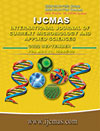


 National Academy of Agricultural Sciences (NAAS)
National Academy of Agricultural Sciences (NAAS)

|
PRINT ISSN : 2319-7692
Online ISSN : 2319-7706 Issues : 12 per year Publisher : Excellent Publishers Email : editorijcmas@gmail.com / submit@ijcmas.com Editor-in-chief: Dr.M.Prakash Index Copernicus ICV 2018: 95.39 NAAS RATING 2020: 5.38 |
Aquatic macrophytes play an important role in the structural and functional aspects of aquatic ecosystems by altering water movement regimes, providing shelter to fish and aquatic invertebrates, serving as a food source, and altering water quality by regulating oxygen balance, nutrient cycles, and accumulating heavy metals (Bradl, 2005). The ability to hyper accumulate heavy metals makes them interesting research candidates, especially for the treatment of industrial effluents and sewage waste water (Pumple et al., 2013). The use of aquatic macrophytes, such as Eichhornia Crassipes with hyper accumulating ability is known to be an environmentally friendly option to restore polluted aquatic resources. The present review highlights the phytoaccumulation potential of macrophytes with emphasis on utilization of Eichhornia Crassipes as a promising candidate for phytoremediation. The impact of uptake of heavy metals on morphology and metabolic processes of Eichhornia Crassipes has also been discussed for a better understanding and utilization of this symbiotic association in the field of phytoremediation.
 |
 |
 |
 |
 |